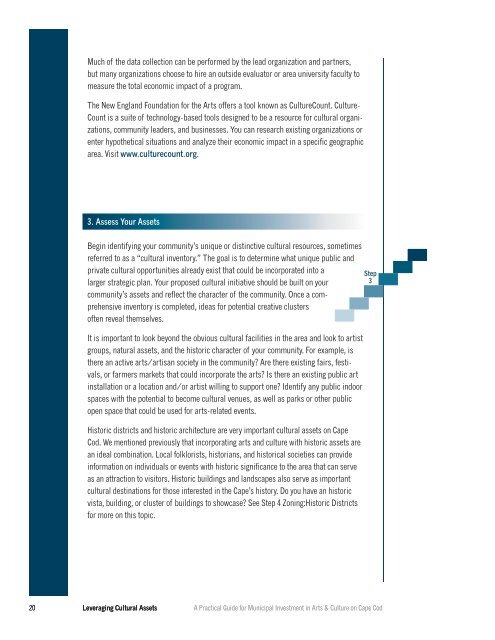Leveraging Cultural Assets for Economic Development - Cape Cod ...
Leveraging Cultural Assets for Economic Development - Cape Cod ...
Leveraging Cultural Assets for Economic Development - Cape Cod ...
- No tags were found...
Create successful ePaper yourself
Turn your PDF publications into a flip-book with our unique Google optimized e-Paper software.
Much of the data collection can be per<strong>for</strong>med by the lead organization and partners,but many organizations choose to hire an outside evaluator or area university faculty tomeasure the total economic impact of a program.The New England Foundation <strong>for</strong> the Arts offers a tool known as CultureCount. Culture-Count is a suite of technology-based tools designed to be a resource <strong>for</strong> cultural organizations,community leaders, and businesses. You can research existing organizations orenter hypothetical situations and analyze their economic impact in a specific geographicarea. Visit www.culturecount.org.3. Assess Your <strong>Assets</strong>Begin identifying your community’s unique or distinctive cultural resources, sometimesreferred to as a “cultural inventory.” The goal is to determine what unique public andprivate cultural opportunities already exist that could be incorporated into alarger strategic plan. Your proposed cultural initiative should be built on yourcommunity’s assets and reflect the character of the community. Once a comprehensiveinventory is completed, ideas <strong>for</strong> potential creative clustersoften reveal themselves.It is important to look beyond the obvious cultural facilities in the area and look to artistgroups, natural assets, and the historic character of your community. For example, isthere an active arts/artisan society in the community? Are there existing fairs, festivals,or farmers markets that could incorporate the arts? Is there an existing public artinstallation or a location and/or artist willing to support one? Identify any public indoorspaces with the potential to become cultural venues, as well as parks or other publicopen space that could be used <strong>for</strong> arts-related events.Historic districts and historic architecture are very important cultural assets on <strong>Cape</strong><strong>Cod</strong>. We mentioned previously that incorporating arts and culture with historic assets arean ideal combination. Local folklorists, historians, and historical societies can providein<strong>for</strong>mation on individuals or events with historic significance to the area that can serveas an attraction to visitors. Historic buildings and landscapes also serve as importantcultural destinations <strong>for</strong> those interested in the <strong>Cape</strong>’s history. Do you have an historicvista, building, or cluster of buildings to showcase? See Step 4 Zoning:Historic Districts<strong>for</strong> more on this topic.Step320<strong>Leveraging</strong> <strong>Cultural</strong> <strong>Assets</strong> A Practical Guide <strong>for</strong> Municipal Investment in Arts & Culture on <strong>Cape</strong> <strong>Cod</strong>
















